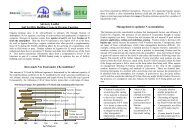A review of leguminous fertility-building crops, with particular ...
A review of leguminous fertility-building crops, with particular ...
A review of leguminous fertility-building crops, with particular ...
Create successful ePaper yourself
Turn your PDF publications into a flip-book with our unique Google optimized e-Paper software.
A <strong>review</strong> <strong>of</strong> <strong>leguminous</strong> <strong>fertility</strong>-<strong>building</strong> <strong>crops</strong>, Defra project OF0316 2. Rotational aspects<br />
over-wintered cruciferous <strong>crops</strong> would provide a green bridge for pests and diseases and<br />
reduce the impact <strong>of</strong> rotational strategies which try to minimise year round production.<br />
2.2.4. Soil remediation effects<br />
The remedial effects <strong>of</strong> <strong>fertility</strong>-<strong>building</strong> <strong>crops</strong> have received some attention and are the<br />
subject <strong>of</strong> on-going research. Literature relating to this has also been considered <strong>with</strong>in the<br />
DOVE project (Defra, OF0168). Brassica crop residues can produce bi<strong>of</strong>umigation effects,<br />
which reduce pests and diseases (Kirkegaard et al., 1996; Morra, 1999; Rosa & Rodrigues,<br />
1999). SAC are currently investigating use <strong>of</strong> cruciferous crop residues for control <strong>of</strong><br />
rhizoctonia diseases in potatoes.<br />
Green manures generally stimulate soil micro-organisms and this can result in suppression <strong>of</strong><br />
pathogens. Control <strong>of</strong> common scab (Streptomyces spp.) <strong>of</strong> potatoes <strong>with</strong> green manures is a<br />
well-known example, though there are concerns that green material could increase the risk <strong>of</strong><br />
slug damage. One mechanism involved is antibiotic production by the bacterium Bacillus<br />
subtilis, which inhibits Steptomyces scabies (Cook & Baker, 1996).<br />
Addition <strong>of</strong> plant residues or organic matter may favour increased activity <strong>of</strong> pathogens <strong>with</strong><br />
strong saprophytic activity. Pot experiments in the DOVE project (OF0168) indicated that<br />
interactions between pathogens and soil micro-organisms were complex, involving not only<br />
N (e.g. straw locked up N and reduced crop growth), pH changes, effects on plant growth as<br />
well as pathogen development. Most studies have examined effects on single pathogens and<br />
further work is required at the field scale to establish net benefits against a range <strong>of</strong> pests and<br />
pathogens.<br />
Bi-cropping may produce benefits through the interaction between plant species. Fertility<br />
<strong>crops</strong> that cover the lower diseased leaves <strong>of</strong> crop plants may reduce the upward splash<br />
dispersal <strong>of</strong> fungal spores such as those <strong>of</strong> Septoria tritici. There have also been effects on<br />
leek rust (Theunissen & Schelling, 1996). Soil borne diseases such as carrot cavity spot<br />
(Pythium violae) have been reduced by clover intercropping (Theunissen & Schelling, 2000).<br />
The mechanisms involved have not been established (Deadman et al., 1996), but it is<br />
possible that the intercrop modified available soil N and thereby reduced activity <strong>of</strong> the<br />
fungal pathogen.<br />
2.2.5. Nitrogen release<br />
The amount and rate <strong>of</strong> release <strong>of</strong> N from <strong>fertility</strong>-<strong>building</strong> <strong>crops</strong> is also likely to influence<br />
disease severity. Nitrogen is <strong>of</strong>ten the limiting factor for microbial growth in soil and it is<br />
likely to influence both beneficial and pathogenic organisms. The N content <strong>of</strong> foliage has a<br />
strong effect in disease severity as demonstrated for yellow rust (Bryson et al., 1995) and the<br />
uptake <strong>of</strong> large quantities <strong>of</strong> N is likely to predispose plants to fungal diseases. The<br />
interaction <strong>of</strong> N <strong>with</strong> disease merits further investigation, so that the appropriate balance<br />
between crop productivity and disease risk can be established.<br />
Written by S Cuttle, M Shepherd & G Goodlass Page 30




